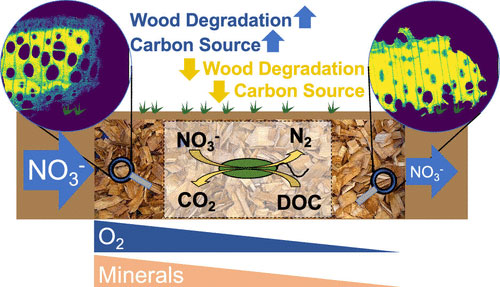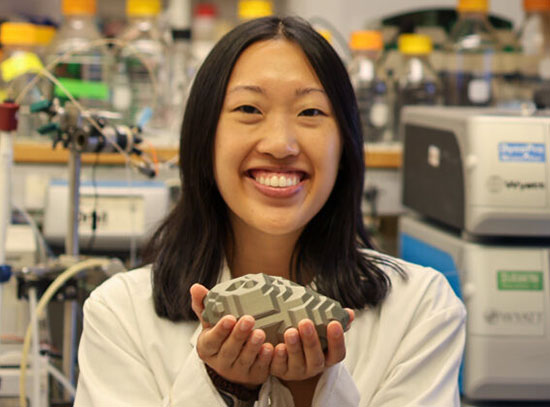Improving Nitrate Removal by Woodchip Bioreactors
August 13, 2025

Scanning X-ray scattering tomography quantified the degradation (blue) of woodchips in the bioreactor. Simultaneously collected fluorescence data confirmed accumulation of metal ions near the surface of degraded woodchips. μXANES from thin sections then revealed redox gradients in Fe and Mn at the surface that likely enhanced wood degradation, which is associated with faster nitrate removal.
The Science
Scientists showed that iron (Fe) and manganese (Mn) can serve as reactive oxidants to enhance wood decomposition in bioreactors.
The Impact
Woodchip bioreactors provide a carbon source for microbes to remove nitrate from agricultural drainage. Understanding how metal ions enhance this process can improve their performance.
Summary
Woodchip bioreactors (WBRs) are important tools for the removal of nitrate in agricultural drainage, but their effectiveness is often limited by the slow degradation of lignocellulosic wood residues into bioavailable forms of carbon that fuel denitrifying microorganisms.
In this work, factors regulating wood degradation in saturated woodchip beds were investigated, with a focus on the effects of dissolved oxygen (DO), iron (Fe), and manganese (Mn) that generate oxidative activity to enhance wood decomposition.
Woodchips from a 10-year-old WBR were characterized with bulk techniques and a novel combination of microbeam X-ray scattering, X-ray fluorescence, and X-ray spectroscopy at the National Synchrotron Light Source II (NSLS-II) LIX (16-ID) and XFM (4-BM) beamlines, respectively, to visualize the depletion of crystalline cellulose as a proxy for wood degradation.
Results showed that woodchips from upstream portions of the reactor exhibited the greatest degradation, probably due to greater DO exposure, and degradation was localized to a 100 to 200 μm thick surface layer that was also associated with higher concentrations of Fe and Mn. Greater degradation was associated with faster nitrate removal. Microbeam X-ray Absorption Near Edge Structure (μXANES) analysis of Fe and Mn in the surface layer indicated the presence of a microenvironment where oxygenation reactions of Fe(II) and Mn(II) could contribute to the formation of reactive oxidants enhancing the degradation of wood, increasing the supply of bioavailable carbon for microbial denitrification.
These results provide new insight into biogeochemical properties that influence wood decomposition in WBRs at both micro- and macroscales and how the wood degradation process is coupled with denitrification.
Download the research summary slide (PDF)
Related Links
https://pubs.acs.org/doi/full/10.1021/acs.est.4c13325
Contact
Matthew C. Reid
Cornell University
mcr239@cornell.edu
Publications
Y. Sang, I. Petrovic, L.E. DuPlooy, Z. Zhang, R. Tappero, M. Ge, L. Yang, M.C. Reid. Biogeochemical controls of wood degradation as a source of bioavailable carbon in denitrifying bioreactors. Environ. Sci. Technol. 59: 11561–11573 (2025). doi: 10.1021/acs.est.4c13325
Funding
This research was funded by NSF award 2237947. Parts of this research used the XFM (4-BM) and LiX (16-ID) Beamlines of the National Synchrotron Light Source II, a U.S. Department of Energy (DOE) Office of Science User Facility operated for the DOE Office of Science by Brookhaven National Laboratory under Contract No. DE-SC0012704. The LiX and XFM beamlines are part of the Center for BioMolecular Structure (CBMS), which is primarily supported by the National Institutes of Health, National Institute of General Medical Sciences (NIGMS) through a P30 Grant (P30 GM133893), and by the DOE Office of Biological and Environmental Research (KP1605010). LiX also received additional support from NIH Grant S10 OD012331.
2025-22586 | INT/EXT | Newsroom









